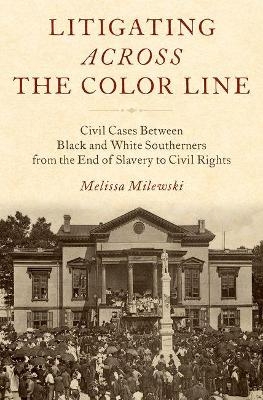
Litigating Across the Color Line
Civil Cases Between Black and White Southerners from the End of Slavery to Civil Rights
Seiten
2017
Oxford University Press Inc (Verlag)
978-0-19-024918-2 (ISBN)
Oxford University Press Inc (Verlag)
978-0-19-024918-2 (ISBN)
In a largely previously untold story, from 1865 to 1950, black litigants throughout the South took on white southerners in civil suits. Drawing on almost a thousand cases, Milewski shows how African Americans negotiated the southern legal system and won suits against whites after the Civil War and before the Civil Rights struggle.
In a largely previously untold story, Melissa Milewski explores how, when the financial futures of their families were on the line, black litigants throughout the South took on white southerners in civil suits. Between 1865 and 1950, in almost a thousand civil cases across eight southern states, former slaves took their former masters to court, black sharecroppers litigated against white landowners, and African Americans with little formal education brought disputes against wealthy white members of their communities.
As black southerners negotiated a legal system with almost all white gatekeepers, they displayed pragmatism and a savvy understanding of how to get whites on their side. They found that certain kinds of cases were much easier to gain whites' support for than others. But they also found that, in the kinds of civil cases that they could litigate in the highest courts of eight states, they were also surprisingly successful. In a tremendously restricted environment in which they were often shut out of other government institutions, seen as racially inferior, and segregated, African Americans found a way to fight for their rights in one of the only ways they could.
This book examines how African Americans adapted and at times made a biased system work for them under enormous constraints. At the same time, it considers the limitations of working within a white-dominated system at a time of great racial discrimination, and the choices black litigants had to make to have their cases heard.
In a largely previously untold story, Melissa Milewski explores how, when the financial futures of their families were on the line, black litigants throughout the South took on white southerners in civil suits. Between 1865 and 1950, in almost a thousand civil cases across eight southern states, former slaves took their former masters to court, black sharecroppers litigated against white landowners, and African Americans with little formal education brought disputes against wealthy white members of their communities.
As black southerners negotiated a legal system with almost all white gatekeepers, they displayed pragmatism and a savvy understanding of how to get whites on their side. They found that certain kinds of cases were much easier to gain whites' support for than others. But they also found that, in the kinds of civil cases that they could litigate in the highest courts of eight states, they were also surprisingly successful. In a tremendously restricted environment in which they were often shut out of other government institutions, seen as racially inferior, and segregated, African Americans found a way to fight for their rights in one of the only ways they could.
This book examines how African Americans adapted and at times made a biased system work for them under enormous constraints. At the same time, it considers the limitations of working within a white-dominated system at a time of great racial discrimination, and the choices black litigants had to make to have their cases heard.
Melissa Milewski is a Lecturer in American History at the University of Sussex in England.
Acknowledgments
Introduction
Prologue
Part 1: Civil Cases Between Black and White Southerners, 1861-1899
Chapter 1 A Revolution in the Courts
Chapter 2 How to Litigate a Case Against a White Southerner
Chapter 3 Challenging Whites' Bequests
Chapter 4 The Law of Contracts and Property
Part 2: Civil Cases Between Black and White Southerners, 1900-1950
Chapter 5 The New South and the Law
Chapter 6 Confronting Fraud Through the Courts
Chapter 7 The Law of Bodily Injury
Chapter 8 Fighting for Rights in the Courts
Epilogue
Appendix A: Notes on Methodology, Sources, and Findings
Appendix B: Tables
Notes
Bibliography
Index
| Erscheinungsdatum | 12.06.2018 |
|---|---|
| Zusatzinfo | 8 hts |
| Verlagsort | New York |
| Sprache | englisch |
| Maße | 239 x 157 mm |
| Gewicht | 621 g |
| Themenwelt | Sachbuch/Ratgeber ► Geschichte / Politik ► Allgemeines / Lexika |
| Geisteswissenschaften ► Geschichte ► Allgemeines / Lexika | |
| Geisteswissenschaften ► Geschichte ► Regional- / Ländergeschichte | |
| Geschichte ► Teilgebiete der Geschichte ► Militärgeschichte | |
| Recht / Steuern ► Allgemeines / Lexika | |
| Recht / Steuern ► EU / Internationales Recht | |
| Recht / Steuern ► Rechtsgeschichte | |
| Sozialwissenschaften ► Politik / Verwaltung | |
| Sozialwissenschaften ► Soziologie | |
| ISBN-10 | 0-19-024918-8 / 0190249188 |
| ISBN-13 | 978-0-19-024918-2 / 9780190249182 |
| Zustand | Neuware |
| Haben Sie eine Frage zum Produkt? |
Mehr entdecken
aus dem Bereich
aus dem Bereich
neueste Manipulationstechniken als Waffengattung der NATO
Buch | Softcover (2023)
Westend (Verlag)
24,00 €
Deutschlands Schwäche in der Zeitenwende
Buch | Softcover (2023)
C.H.Beck (Verlag)
18,00 €


